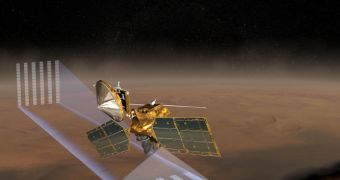Anticipating for the arrival of the next NASA spacecraft on the Red Planet, the MRO has begun a four-week-long study on the Martian atmosphere.
The study is meant to inform mission controllers about the conditions that the Mars Science Laboratory (MSL) mission will face in about a year, when it's due to arrive at the Red Planet.
The conditions that the rover will face are a determining factor in the way its heat shield will be constructed and calibrated, as well as in the angle at which it will enter the atmosphere.
Given that the atmosphere is made almost entirely out of carbon dioxide, it stands to reason that its traits repeat themselves faithfully year after year. This is why this research will be valid in a year from now as well.
The efforts will be conducted using the Mars Climate Sounder (MCS) instrument on the NASA Mars Reconnaissance Orbiter (MRO). The spacecraft has been orbiting the planet since 2006.
The MSL, now named Curiosity, is an important mission in the American space agency's arsenal, as it includes the landing of a ton of nuclear-powered equipment on a foreign celestial body.
The rover will have virtually none of the limitations Spirit and Opportunity have, but additional strengths, including lasers to conduct investigations from afar, and combustion chambers for burning and analyzing samples.
It is the most advanced robot ever deployed to space, and one of the first to have the specific mission of finding potential traces of organic molecules on the Red Planet.
In other words, it's its job to determine if conditions on our neighboring planet allow, or allowed, for life to exist and develop there. The MSL is scheduled to land in August 2012.
The new investigation is being carried out a Martian year (687 Earth days) before the scheduled landing date. What the MCS will do is map the distribution of temperature, dust, and water ice in the atmosphere.
“It is currently one Mars year before the Mars Science Laboratory arrival season,” explains David Kass, who holds an appointment as an atmospheric scientist at the NASA Jet Propulsion Laboratory (JPL), in Pasadena, California.
“This campaign will provide a set of observations to support the Mars Science Laboratory engineering team and Mars atmospheric modelers,” he goes on to say.
“The information will constrain the expected climate at their landing season. It will also help define the range of possible weather conditions on landing day,” the expert concludes.

 14 DAY TRIAL //
14 DAY TRIAL //